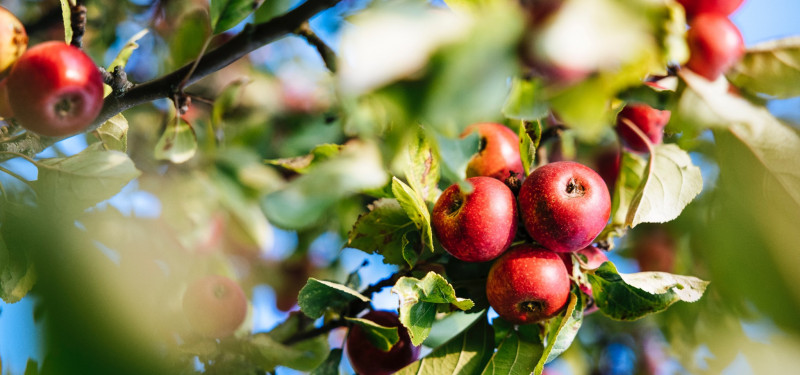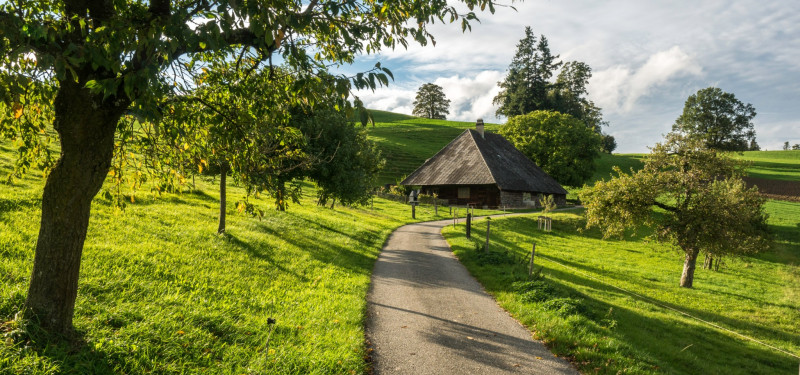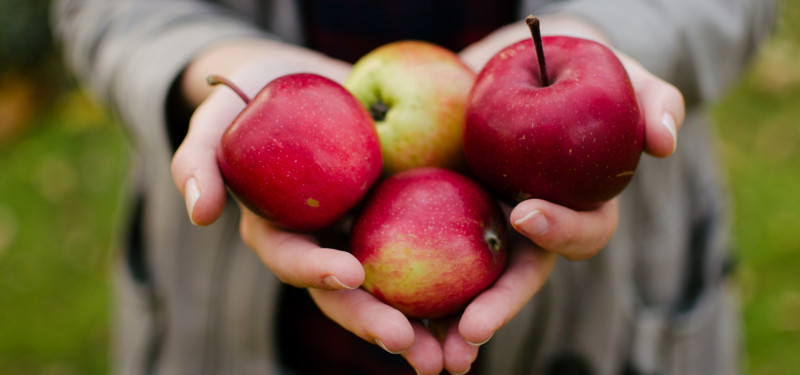Why Cultivate a Lobo Apple Tree in Your Garden?
Embracing the idea of introducing a Lobo Apple tree to your garden opens a door to a myriad of compelling reasons. Much like other fruit trees, the Lobo Apple tree offers more than just a harvest; it adds a touch of natural elegance to your outdoor space. The lush foliage of the Lobo Apple tree, coupled with its delicate blossoms, creates an ornamental spectacle that enhances the aesthetic appeal of your backyard. Picture the beauty of the tree's transformation through the seasons, from the delicate blossoms heralding spring to the vibrant hues of ripening apples in the fall.
Beyond the visual allure, a Lobo Apple tree serves as a natural provider of shade, transforming your garden into a cool haven during warmer days. Selecting varieties that grow tall and have ample space underneath allows you to envision moments of respite beneath the apple-laden branches. Picture yourself, book in hand, enjoying a serene afternoon under the cooling embrace of your own Lobo Apple tree—a retreat that combines comfort and natural splendor.
However, the most compelling motivation for incorporating a Lobo Apple tree into your backyard lies in the delectable harvest it promises. As the tree matures and begins to bear fruit, you'll be rewarded not only with crisp and succulent apples for personal consumption but also with an abundance that can be shared with friends, family, and neighbors. The joy of indulging in fresh, homegrown apples extends to the culinary realm—imagine crafting homemade preserves, tantalizing jellies, and delightful pies, all infused with the authentic flavor of your very own Lobo Apples. This journey isn't just about cultivating a tree; it's about cultivating a source of nourishment, joy, and community spirit right in your backyard. So, consider planting a Lobo Apple tree—a decision that transcends the ordinary and transforms your garden into a flourishing orchard of possibilities.
Planting Your Own Lobo Apple Tree: A Step-by-Step Guide
Embarking on the journey of planting a Lobo Apple tree in the UK promises not just a fruitful harvest but a delightful process of cultivation. Here's your comprehensive guide to ensure your Lobo Apple tree thrives and yields the delectable apples it's renowned for.
1. Choosing the Right Location:
Selecting an optimal location is paramount for the success of your Lobo Apple tree. Ensure it receives full sunlight and is sheltered from strong winds. Well-drained soil is essential, and slightly acidic to neutral soil pH is preferred.
2. Preparing the Soil:
Before planting, enrich the soil with organic matter such as compost. This enhances drainage and provides essential nutrients for your Lobo Apple tree to establish strong roots. Aim for a soil pH between 6.0 and 7.0.
3. Selecting the Right Tree:
When acquiring a Lobo Apple tree, opt for a healthy specimen from a reputable nursery. Choose a tree with a straight, sturdy trunk and well-distributed branches. Bare-root trees are typically suitable for planting in late autumn to early spring.
4. Planting Your Lobo Apple Tree:
a. Dig a Hole: Create a hole twice the width of the root ball and just as deep.
b. Position the Tree: Place the tree in the center of the hole, ensuring the roots are spread out and not cramped.
c. Backfill with Soil: Refill the hole with the enriched soil, gently firming it around the roots.
d. Watering: Give your newly planted tree a thorough watering to settle the soil and hydrate the roots.
5. Mulching and Support:
Apply a layer of organic mulch around the base of the tree, keeping it a few inches away from the trunk. This helps retain moisture and suppress weeds. For support, use stakes to anchor the tree and protect it from strong winds.
6. Pruning and Shaping:
In the first year, focus on pruning to encourage a strong framework. Remove any dead or damaged branches and shape the tree for optimal growth. Subsequent years will involve maintenance pruning to ensure a healthy structure.
7. Watering and Feeding:
Consistent watering, especially during dry spells, is crucial for your Lobo Apple tree's health. Additionally, feed it with a balanced fertilizer in early spring to support robust growth and fruit development.
8. Pollination Considerations:
Lobo Apple trees benefit from cross-pollination. If space allows, consider planting another apple tree nearby to enhance fruit production. Ensure the varieties bloom simultaneously for effective pollination.
9. Harvesting:
Be patient during the initial years as your Lobo Apple tree establishes itself. Once mature, the apples are typically ready for harvest in early to mid-autumn. Harvest when the fruit is firm, flavorful, and has reached its vibrant red color.
10. Enjoying the Fruits of Your Labor:
The culmination of your efforts arrives when you savor the crisp, juicy Lobo Apples from your very own tree. Whether enjoyed fresh, baked into pies, or transformed into preserves, your homegrown Lobo Apples are a testament to the joys of cultivating your orchard.
By following these steps, you'll not only plant a Lobo Apple tree but cultivate a thriving addition to your garden that will yield delicious apples for years to come. Happy planting!
Guarding Your Lobo Apple Tree: A Guide to Pest and Disease Management in the UK
Cultivating a luscious Lobo Apple tree in the UK is a rewarding endeavor, but ensuring its health requires vigilant pest and disease management. Let's delve into a comprehensive guide to protect your apple orchard investment.
1.Know Your Foes:
Understanding the potential adversaries your Lobo Apple tree may face is the first step. Common pests include aphids, codling moths, and apple maggots. Diseases such as apple scab, powdery mildew, and fire blight are also potential threats.
2. Regular Inspections:
Initiate a proactive approach by regularly inspecting your Lobo Apple tree. Check the leaves, branches, and fruit for any signs of pests or diseases. Early detection allows for swift intervention and prevents potential damage.
3. Natural Predators:
Harness the power of nature by encouraging natural predators. Ladybugs, lacewings, and predatory beetles are beneficial insects that feed on common pests. Creating a habitat that attracts these allies contributes to a balanced ecosystem in your orchard.
4. Pruning Practices:
Pruning isn't just for shaping; it's a vital component of pest and disease management. Remove dead or diseased branches promptly to prevent the spread of infections. Opening up the canopy also improves air circulation, minimizing conditions conducive to diseases.
5. Organic Remedies:
Opt for organic remedies to combat pests and diseases. Neem oil, insecticidal soap, and horticultural oils are effective against pests without harming beneficial insects. Copper-based fungicides can be utilized for disease prevention.
6. Cultural Practices:
Implement cultural practices that deter pests. Rake fallen leaves to reduce overwintering sites for insects and pathogens. Thinning fruit clusters promotes better air circulation and reduces the risk of diseases.
7. Biological Controls:
Explore biological controls, such as releasing beneficial nematodes into the soil to combat soil-dwelling pests. This eco-friendly method contributes to the overall health of your orchard.
8. Timely Watering:
Maintain a consistent watering schedule to promote the overall health of your Lobo Apple tree. Adequate hydration contributes to the tree's ability to resist diseases, especially those related to stress factors.
9. Disease-Resistant Varieties:
Consider planting disease-resistant apple varieties, including specific cultivars of Lobo Apples. These varieties are bred to withstand common diseases, reducing the likelihood of infections.
10. Seek Professional Advice:
If pest or disease issues persist, don't hesitate to seek advice from local horticulturists or agricultural extension services. They can provide tailored solutions and guidance based on the specific challenges in your region.
By combining these proactive measures, you can create a robust defense system for your Lobo Apple tree, ensuring a healthy and bountiful harvest. Remember, a thriving orchard is a result of both nurture and protection.
Nurturing Your Lobo Apple Tree: Essential Product Recommendations for UK Orchards
Elevating the cultivation of your cherished Lobo Apple tree in the UK involves not just passion but also the right arsenal of products to ensure its thriving health and bountiful harvest. Here's a curated guide to essential recommendations for the discerning apple orchard enthusiast.
1. Premium Soil Enrichment:
Start your Lobo Apple tree's journey right from the roots with a premium soil enrichment mix. Composed of organic matter, these enrichments bolster soil health, providing the ideal foundation for your apple tree to flourish.
2. Neem Oil for Pest Management:
Combat common pests like aphids with the natural prowess of neem oil. This organic remedy serves as a potent deterrent against unwanted visitors, ensuring your Lobo Apple tree remains pest-free without compromising the health of beneficial insects.
3. Insecticidal Soap for Gentle Defense:
For a gentle yet effective approach to pest control, invest in insecticidal soap. This product targets soft-bodied pests while leaving beneficial insects unharmed. It's a meticulous solution for maintaining the delicate balance of your orchard ecosystem.
4. Horticultural Oils for Disease Prevention:
Ward off potential diseases such as apple scab with horticultural oils. These oils act as a protective shield, creating an inhospitable environment for pathogens while keeping your Lobo Apple tree's foliage vibrant and healthy.
5. Beneficial Nematodes for Soil Health:
Harness the power of beneficial nematodes to combat soil-dwelling pests. These microscopic warriors contribute to a balanced soil ecosystem, enhancing the overall vitality of your orchard.
6. Copper-Based Fungicides for Disease Resistance:
When it comes to disease prevention, copper-based fungicides stand out. Formulated to thwart common apple diseases, these fungicides offer a reliable defense against the likes of powdery mildew, ensuring your Lobo Apple tree stands resilient.
7. Sturdy Tree Stakes for Support:
Provide essential support to your Lobo Apple tree with sturdy tree stakes. Especially crucial during its early years, these stakes anchor the tree against strong winds, safeguarding its growth and preventing potential damage.
8. Organic Mulch for Moisture Retention:
Create a protective layer around the base of your Lobo Apple tree with organic mulch. This not only suppresses weeds but also retains moisture, ensuring your tree stays hydrated during dry spells.
9. Fruit Tree Fertilizer for Nutrient Boosts:
Fuel the growth of your Lobo Apple tree with a specialized fruit tree fertilizer. Rich in essential nutrients, these fertilizers provide the nourishment your tree needs for robust development and a fruitful harvest.
10. Pruning Tools for Precision:
Invest in high-quality pruning tools to maintain the health and structure of your Lobo Apple tree. Regular pruning encourages optimal airflow, minimizes disease risk, and shapes the tree for an aesthetically pleasing orchard landscape.
By incorporating these carefully selected products into your orchard care routine, you're not just tending to a tree; you're cultivating a flourishing haven for your Lobo Apple tree to thrive in the vibrant UK landscape. Happy cultivating!


